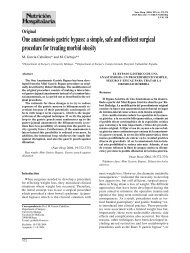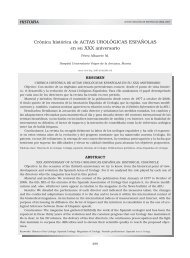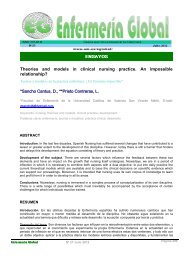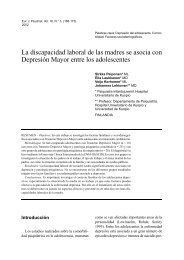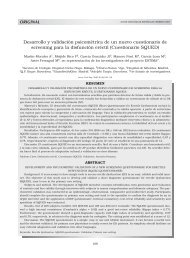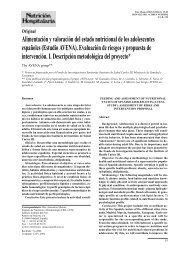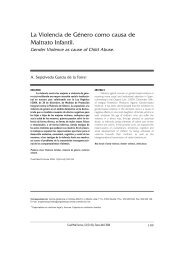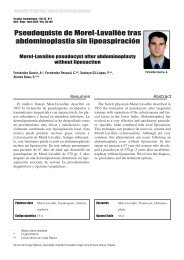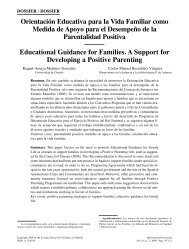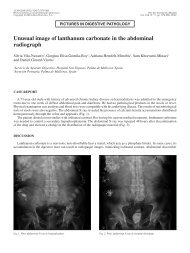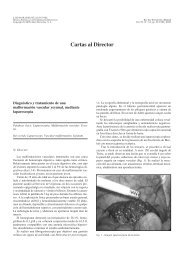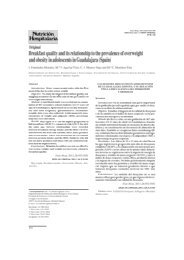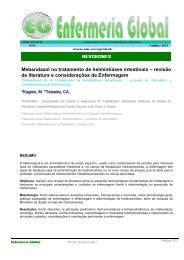fournier's gangrene: our experience in 5 years, bibliographic
fournier's gangrene: our experience in 5 years, bibliographic
fournier's gangrene: our experience in 5 years, bibliographic
You also want an ePaper? Increase the reach of your titles
YUMPU automatically turns print PDFs into web optimized ePapers that Google loves.
The diagnosis was based on cl<strong>in</strong>ical fi nd<strong>in</strong>gs.<br />
Conventional radiology can be helpful <strong>in</strong> assess<strong>in</strong>g<br />
some cases reveal<strong>in</strong>g the presence of gas <strong>in</strong> soft tissues.<br />
This is not pathognomonic but must warn of<br />
the possibility of necrotis<strong>in</strong>g subcutaneous <strong>in</strong>fection.<br />
Ultrasound can be useful for dist<strong>in</strong>guish<strong>in</strong>g between<br />
F<strong>our</strong>nier’s <strong>gangrene</strong> and other diseases that occur<br />
with scrotal pa<strong>in</strong>, erythema and scrotal volume <strong>in</strong>crease.<br />
CT and MRI can help us to del<strong>in</strong>eate the extent of<br />
<strong>in</strong>fection and location of outbreaks. These studies are<br />
essential for a correct diagnosis and offer appropriate<br />
treatment. In <strong>our</strong> series, no methods were used for<br />
imag<strong>in</strong>g studies due to diagnostic certa<strong>in</strong>ty provided<br />
by the cl<strong>in</strong>ic as well as the lateness of the table at the<br />
beg<strong>in</strong>n<strong>in</strong>g.<br />
The basis of treatment is an early and aggressive<br />
radical action with surgical debridement (18),<br />
as has been documented that once it establishes this<br />
gas <strong>gangrene</strong> often advance to 1cm for h<strong>our</strong>s (26),<br />
so that once the diagnosis is essential to the surgical<br />
debridement and as early as the F<strong>our</strong>nier’s <strong>gangrene</strong><br />
is dynamic sometimes you can not remove 100% of<br />
the necrotic tissue with the fi rst debridament (17), for<br />
this to be very aggressive so it is not uncommon for<br />
patients requir<strong>in</strong>g more a surgical debridement before<br />
be<strong>in</strong>g considered as resolved <strong>in</strong>fection, as <strong>in</strong> this<br />
revision, as we reported a rate of 1.68 surgeries per<br />
patient with a range that varied from 1 to 5.<br />
The leads from the ur<strong>in</strong>ary tract as a tract<br />
gastro<strong>in</strong>teest<strong>in</strong>al are sometimes necessary to ensure<br />
proper development of the wound and prevent contam<strong>in</strong>ation<br />
of the same, we fi nd that cystostomy was<br />
performed to 32% of <strong>our</strong> patients and colostomy only<br />
10% of these.<br />
In <strong>our</strong> study, all patients received antimicrobial<br />
therapy of fi rst <strong>in</strong>stance with a double outl<strong>in</strong>e based<br />
Ofl oxac<strong>in</strong> 400mg IV every 12hrs more Cl<strong>in</strong>damyc<strong>in</strong><br />
600mg IV every 6hrs, cover<strong>in</strong>g this way gramm<br />
negative, positive and anaerobic, this scheme was<br />
modifi ed after it had the antibiogram and the culture<br />
of the abscess secretion, which never exceeded 7<br />
days.<br />
On admission all patients received surgical<br />
and medical management as soon as possible <strong>in</strong> this<br />
way try<strong>in</strong>g to avoid <strong>in</strong>creased morbidity and complications<br />
death of the patient, and analyz<strong>in</strong>g this<br />
situation we fi nd that there are several attempts to predict<br />
the prognosis of patients with F<strong>our</strong>nier’s <strong>gangrene</strong>,<br />
Laora et al. (8) <strong>in</strong> 1995 and designed the FGSIS<br />
(F<strong>our</strong>niers’s Gangrene Severity Index Score) which is<br />
a modifi cation of the already known APACHE II (Acute<br />
Physiology and Chronic Health Evaluation II) <strong>in</strong> which<br />
they found that patients who survived were found <strong>in</strong><br />
FOURNIER’S GANGRENE: OUR EXPERIENCE IN 5 YEARS...<br />
TABLE I. SEVERITY INDEX OF FOURNIER’S GANGRENE.<br />
Abnormally high values Normal Anomalously low values.<br />
Physiological Physiological Physiological Physiological Physiological Physiological Physiological Variable / / Value Value given given +4 +4 +4 +4 +4 +4 +4 +3 +3 +2 +2 +1 +1 0 0 +1 +1 +2 +2 +3 +3 +4<br />
+4<br />
Temperature (OC). >41 39-40.9 – 38.5-38.9 36-38.4 34-35.9 32-33.9 30-31.9 180 140-179 110-139 – 70-109 – 55-69 40-54 50 35-49 – 25-34 12-24 10-11 6-9 -- 180 160-179 155-159 150-154 130-149 – 120-129 111-119 7 6-6.9 – 5.5-5.9 3.5-5.4 3-3.4 2.5-2.9 -- --<br />
Serum creat<strong>in</strong><strong>in</strong>e (mg/100ml x 2 >3.5 2-3.4 1.5-1.9 – 0.6-1.4 -- 60 – 50-59.9 46-49.9 30-45.9 – 20-29.9 -- 40 – 20-39.9 15-19.9 3.-14.9 – 1-2.9 -- 52 41-51.9 – 32-40.9 22-31.9 – 18-21.9 15-17.9



